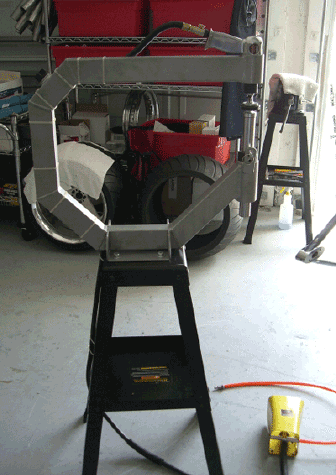The Planishing Hammer
A planishing hammer or maybe more than one is a necessity if you plan to shape sheetmetal into parts for your motorcycle or chopper. The name sounds a bit intimidating but the tool itself is pretty simple once you understand the concept. However, using this tool well takes a bit of practice. This piece of shop equipment is used for shaping and finely smoothing metal forms.
Derived from the Latin planus, meaning "flat", the plannishing hammer has a flat head which is struck against a planishing stake. You may be thinking that most hammers except ball peen hammers have a flat surface for striking, but in common hammers, that surface is small and is intended to strike a small surface such as a nail or stake. In the case of a planishing hammer, the flat surface is much larger because it is intended to strike an area on a sheet of metal.

The concept of planishing to finely shape metals began far back into history. The first known plannishing hammers were used by medieval craftsmen to shape armor. The manually powered hammer is still used today, but technology has advanced to provide other, easier to use alternatives. One of the first advances was the foot powered device, but today pneumatic and hydraulic models make work much easier. But even today, the manually operated tool is used for the finest shaping on parts which only need the final touch of shaping added to complete the desired shape. Manual hammers are also used on small pieces of metal.
To use a planishing hammer, a plannishing stake is required. This device is simply a piece of metal with a shaped top on which the sheetmetal is placed before striking with the hammer. The stake is held in position by a vice or installed into the mounting hole in a blacksmith's beak anvil. In some cases, when working on small pieces of sheet metal, the stake may be replaced by hand held metal tools called Dollys or Anvils.
While one planishing hammer can be used to create many shapes, the stake, dolly or anvil has to be shaped so that the desired contour will be forced into the sheet metal when it is struck by the hammer. Therefore, one or two planishing hammers can be used to work with a variety of stakes. There are many, many shapes available in plannishing stakes of many different sizes.
Novice often use hammers made of hardwood or covered with rawhide. When using wood or rawhide, the process of plannishing is slower and requires more strikes but it is less easy to make an error and damage the sheet metal. One of the most common errors made by beginners to the planishing process is dimpling the metal because of using too much striking force.
This error does not readily occur with wooden or rawhide plannishing hammers. These options, however, do not work well for large or thick sheet metal. Large jobs are more often performed with air-powered or hydraulic tools which can strike hundreds of blows per minute if desired.
Related Articles:
Tubing Bender
DOM Tubing and Motorcycle Frame Tubing: What To Use.
Highly Recommended!
Build Your Own Tube Bender With This 40 Page Guide -- Tube Bender Plans.
Build Your Own English Wheel -- English Wheel Plans.
